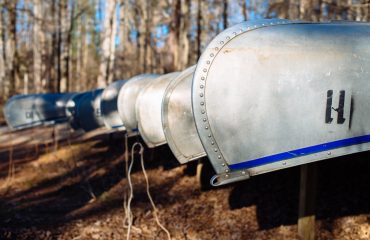body {
font-family: sans-serif;
line-height: 1.6;
}
h1, h2, h3 {
color: #333;
}
img {
max-width: 100%;
height: auto;
}
Scaffolding is an integral part of any construction project, providing a safe and stable working platform for workers at heights. At the heart of most scaffolding systems lie scaffolding pipes – the robust and versatile components that form the backbone of these temporary structures. This comprehensive guide delves into the world of scaffolding pipes, exploring their various types, applications, safety considerations, regulations, and future trends.
Types of Scaffolding Pipes Used in Construction
Scaffolding pipes are typically made from high-strength steel, designed to withstand significant loads and environmental factors. Several types are commonly used, each with its own strengths and weaknesses:
- Standard Scaffolding Pipes: These are the most common type, usually black, galvanized, or powder-coated to prevent corrosion. Their diameter and wall thickness vary depending on the intended load and application.
- Lightweight Scaffolding Pipes: These pipes offer a good balance between strength and weight, making them easier to handle and transport. They are often used in smaller projects or where accessibility is limited.
- Heavy-Duty Scaffolding Pipes: Designed for exceptionally heavy loads and demanding applications, these pipes have thicker walls and higher tensile strength. They are frequently used in large-scale projects or where extreme stability is required.
- Aluminum Scaffolding Pipes: While less common than steel, aluminum pipes offer significant weight advantages, making them suitable for certain applications. However, they may not be as strong as steel pipes and are generally more expensive.
The choice of pipe type depends on factors such as the height of the scaffold, the anticipated load, the environmental conditions, and the overall project requirements.
Applications of Scaffolding Pipes Across Diverse Construction Projects
Scaffolding pipes are incredibly versatile and find applications across a wide range of construction projects, including:
- Building Construction: Providing access for bricklayers, painters, electricians, and other tradespeople working on exterior walls and high-level areas.
- Bridge Construction: Supporting workers and equipment during the construction and maintenance of bridges.
- Industrial Construction: Creating platforms for maintenance and repair work on large industrial structures.
- Renovation Projects: Providing safe access to upper floors and areas during renovations and repairs.
- Event Staging: Constructing temporary platforms and stages for concerts, festivals, and other events.
The adaptability of scaffolding pipes allows for the creation of customized scaffolding systems tailored to the specific needs of each project.
Safety Regulations and Best Practices for Scaffolding Pipe Usage
The safe use of scaffolding pipes is paramount. Strict adherence to safety regulations and best practices is essential to prevent accidents. These include:
- Regular Inspections: Thorough inspections of scaffolding pipes and fittings should be conducted before, during, and after use to identify any damage or defects.
- Proper Erection and Dismantling: Scaffolding should be erected and dismantled by trained and competent personnel following established procedures.
- Load Capacity: The scaffolding system must be designed and constructed to support the anticipated load, taking into account the weight of workers, materials, and equipment.
- Fall Protection: Appropriate fall protection measures, such as guardrails, toe boards, and safety nets, should be implemented to protect workers from falls.
- Compliance with Regulations: All scaffolding must comply with relevant national and local safety regulations and standards.
Negligence in safety procedures can lead to serious injuries or fatalities. Prioritizing safety is crucial throughout the entire scaffolding lifecycle.
Maintaining and Extending the Lifespan of Scaffolding Pipes
Proper maintenance significantly extends the lifespan of scaffolding pipes and ensures their continued safety and reliability. Key maintenance practices include:
- Regular Cleaning: Removing dirt, debris, and corrosion from pipes helps prevent damage and extends their service life.
- Corrosion Protection: Applying protective coatings, such as paint or galvanizing, can significantly improve the resistance of pipes to corrosion.
- Damage Repair: Damaged pipes should be repaired or replaced immediately to prevent accidents.
- Proper Storage: Scaffolding pipes should be stored in a dry, protected area to prevent corrosion and damage.
- Regular Inspections: Routine inspections can identify potential issues before they become serious problems.
Investing in proper maintenance is cost-effective in the long run, minimizing the need for premature replacements and ensuring worker safety.
Future Trends in Scaffolding Pipe Technology and Usage
The construction industry is constantly evolving, and the use of scaffolding pipes is no exception. Emerging trends include:
- Lightweight Materials: Research and development are focusing on lighter yet stronger materials to reduce the weight and improve the handling of scaffolding systems.
- Smart Scaffolding: Integration of sensors and technology to monitor the structural integrity of scaffolding in real-time, improving safety and efficiency.
- Modular Scaffolding Systems: The development of prefabricated and modular scaffolding systems simplifies erection and dismantling, reducing time and labor costs.
- Sustainable Materials: Increased focus on using recycled and sustainable materials in the production of scaffolding pipes to minimize environmental impact.
- Improved Fittings and Couplings: Innovations in fittings and couplings aim to enhance the speed and ease of assembly and disassembly, as well as improve stability and safety.
These advancements promise to make scaffolding systems safer, more efficient, and more environmentally friendly in the years to come.
In conclusion, scaffolding pipes are essential components in the construction industry, playing a critical role in ensuring worker safety and project success. Understanding their types, applications, safety regulations, maintenance, and future trends is vital for anyone involved in construction or related fields.
SEO Tags: scaffolding pipes, construction scaffolding, scaffolding safety, scaffolding regulations, scaffolding materials




